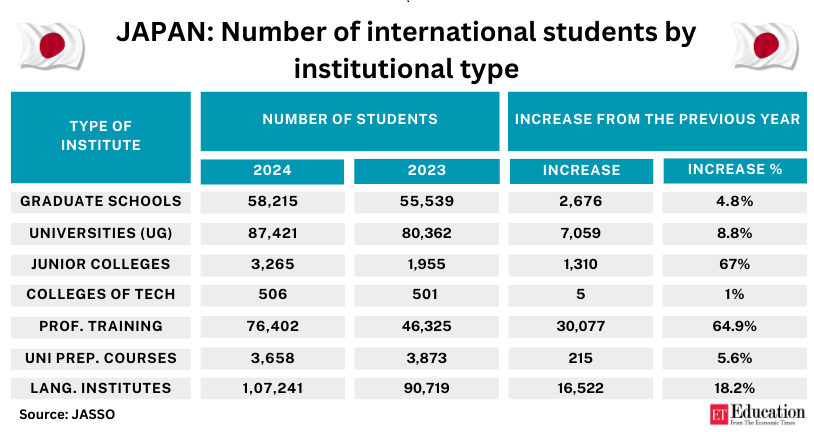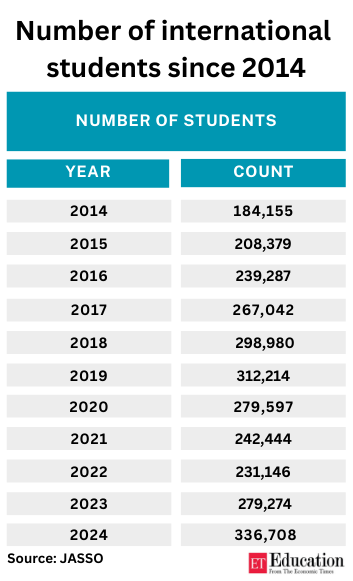
Japan Emerges as a New Study-Abroad Destination for Indian Students, ETEducation

For decades, the script for Indian students aspiring to study abroad has remained predictable: the United States, the United Kingdom, Australia and Canada. These “Big Four” destinations dominate conversations in classrooms, counselling sessions and dinner-table debates, shaping aspirations with the promise of global exposure and lucrative careers.
But as Western markets grapple with rising costs, restrictive visa regimes and mounting employability concerns, a new chapter is quietly unfolding in Asia. Japan, long overlooked, is emerging as an unexpected yet compelling frontier for Indian students.
To address the gap, India and Japan have jointly announced a target of 15,000 Indian students in Japan over the next three years.
During his recent visit to the East Asian nation, India’s Prime Minister Narendra Modi announced substantial investment over the next ten years. More importantly, he said an action plan will be created for human resource exchange in the next five years across different sectors between India and Japan, providing much-needed impetus to ongoing efforts to increase exchange with the Indian demographic.
Industry experts say that since Japan does not have a formal immigration policy, talent inflow largely depends on education. The country has reported a sharp 20 percent jump in international students compared with last year, with admissions in junior colleges registering the largest growth of 67 percent.

The Japanese government has set a broader goal: to host 400,000 international students by 2033, making India a crucial partner in this expansion. The University of Tokyo, for instance, already has more than 100 Indian students enrolled across undergraduate, postgraduate and doctoral levels, and aims to double that number within five years.
“The University of Tokyo’s vision, aligned with the Study in Japan initiative, is to significantly expand Indian student enrolment. Over the next five years, our goal is to double the number of Indian students across undergraduate and graduate levels, with a focus on diverse disciplines beyond STEM, such as design, policy, humanities and social sciences,” said Hargun Luthra, Senior Recruitment Advisor, South Asia, supporting the University of Tokyo, Japan.
Why Japan makes sense now
Several factors explain why Japan is gaining traction. Affordability is one. With the rising cost of education in the ‘Big Four’, tuition fees at leading Japanese universities typically range between Rs 3 lakh and Rs 5 lakh annually – lower than what many private institutions in India charge.
According to Sagar Bahadur, Executive Director – Asia and Head of Regional Strategy at study-abroad consultancy Acumen, scholarships such as MEXT and JASSO, which cover tuition and living expenses, strengthen the financial case further.
Living costs, often cited as a deterrent, are also more manageable than many assume. “In Tokyo, a one-bedroom apartment typically costs between 50,000 and 80,000 Japanese yen per month (USD 340–550), while dormitories and shared housing are more affordable at 30,000–50,000 yen,” explained Saurabh Arora, Founder and CEO of University Living.
“Overall monthly expenses in Tokyo range from USD 1,500 to 2,000, whereas smaller cities can be as low as USD 800 to 1,200. This cost flexibility enables students to access world-class education at a lower overall cost compared with many Western destinations,” he added.
From classrooms to careers
For Indian families, education is inextricably tied to employability. Here too, Japan is positioning itself strategically. With its population shrinking year after year, the country faces demographic pressures that could translate into workforce shortages running into the hundreds of thousands by 2030.
Multinationals are adapting as well: Uniqlo has committed to hiring 100 Indian students annually, while Japanese universities have expanded career support through structured internships, job fairs and alumni networks.
“Graduate salaries average 3-5 million Japanese yen annually, and recent policy reforms are easing the transition from study to work. Where Japan stands out is in the strength of its industry linkages, with employers actively seeking talent in manufacturing, IT/data and health-tech – driven by demographic pressures pointing to shortfalls in the hundreds of thousands by 2030,” said Akshay Chaturvedi, Founder and CEO of study-abroad consultancy Leverage Edu.
Leverage Edu has been piloting Japan as a destination via Nepal as a source market for the past few months, and may roll out its axis across India and South-East Asia towards the end of this year.
Similarly, Acumen is collaborating with JETRO (Japan External Trade Organization) to connect Japanese companies with Indian institutions, creating direct talent pipelines. The company has also recently announced the launch of Navi Japan, a one-stop app and personalised student support service.
The weight of Western competition
Japan faces stiff competition. According to the Institute of International Education (IIE)’s Open Doors report, India was the top country of origin with 3.31 lakh students in the United States – a 23 percent increase over the previous academic year of 2022–23.
Canada and the United Kingdom are hosting similar numbers of Indian students. China, too, has traditionally been a magnet for Asian students, although geopolitical tensions have altered flows in recent years.
For Japan, breaking through this crowded field is daunting. As a Ministry of External Affairs (MEA) official told ET Education, “The aspirations of Indian students are still heavily tilted towards the West. The challenge for Japan is not quality, it’s visibility. Our task, in collaboration with the Japanese government, is to build trust and awareness so families see Japan as a serious long-term option.”
For many Indian students, hesitation stems more from perception than reality. “When I told my friends I was going to Japan for my master’s in sustainability studies, they were surprised – it wasn’t even on their radar,” said a 24-year-old student at Kyoto University.
“But once I arrived, I realised the facilities, the research focus and even the affordability are far better than I had imagined. The only real challenge is learning the language, but my university offers free classes, and I see it as an advantage in the long run,” she added.
In a sector where narratives shift slowly, Japan is positioning itself not as a competitor to the West but as an alternative model – one built on integration, affordability and long-term opportunity.
If the target of 15,000 Indian students in three years is met, this corridor may well become Asia’s most closely watched educational experiment.
Source link






